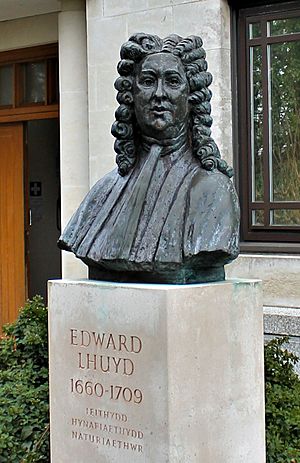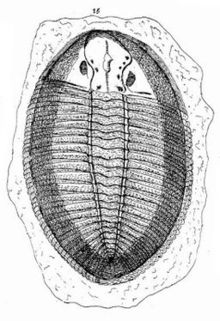Edward Lhuyd facts for kids


Edward Lhuyd (pronounced LOYD) was a very important Welsh scientist and scholar. He lived from 1660 to 1709. He was a naturalist (someone who studies nature), a botanist (plant expert), a linguist (language expert), a geographer (studies the Earth's features), and an antiquary (someone who studies old things). He helped us learn a lot about the natural world and the history of languages in Great Britain.
Contents
Edward Lhuyd's Early Life and Work
Edward Lhuyd was born in 1660 in a place called Loppington, England. His family was from Wales. He went to Oswestry Grammar School and later studied at Jesus College, Oxford. In 1684, he started working at the Ashmolean Museum in Oxford. This museum collects and displays old and interesting things. He became the main person in charge of the museum in 1690 and stayed there until he died.
While working at the Ashmolean, Lhuyd traveled a lot. In 1688, he visited Snowdonia in Wales. There, he made a list of all the different plants he found. This list was used in a famous book about British plants.
After 1697, Lhuyd explored every county in Wales. He also traveled to Scotland, Ireland, Cornwall, Brittany (in France), and the Isle of Man. These trips helped him learn about the plants, rocks, and languages of these areas.
In 1699, with help from his friend Isaac Newton, Lhuyd published a special book. It was the first-ever catalog of fossils! He called it Lithophylacii Britannici Ichnographia. These fossils were mostly found in England, near Oxford. Today, they are kept at the Ashmolean Museum.
Lhuyd received a special Master's degree from the University of Oxford in 1701. He also became a member of the important Royal Society in 1708. The Royal Society is a group for top scientists.
In 1696, Lhuyd carefully copied an old Latin message. This message was carved on the 9th-century Pillar of Eliseg in Wales. Over time, the carving became hard to read because of the weather. But Lhuyd's copy was very accurate and helps us understand it today.
Lhuyd was also the first person to scientifically describe a dinosaur tooth. He named it Rutellum impicatum. This tooth belonged to a type of long-necked dinosaur called a sauropod.
He also made the first written record of a trilobite. Trilobites were ancient sea creatures that looked a bit like woodlice. In 1688, Lhuyd wrote about finding what he called a "skeleton of some flat fish." Today, we know this was a trilobite called Ogygiocarella debuchii.
Edward Lhuyd: A Pioneer in Languages
In the late 1600s, a group of scholars from Cornwall asked Lhuyd for help. They wanted to save and learn more about the Cornish language. Lhuyd accepted their invitation and traveled to Cornwall to study it.
In 1702, Lhuyd published a paper about Early Modern Cornish. This was a newer form of the language, with simpler rules than the older medieval version.
In 1707, Lhuyd published his most famous book, Archaeologia Britannica. He got help from another Welsh scholar, Moses Williams, for this huge project. The book was about the languages, histories, and customs of Great Britain. It included information from his travels through Wales, Cornwall, Brittany, Ireland, and Scotland.
This book was very important for understanding how languages change over time. Many ideas about language that people thought were new in the 1800s actually came from Lhuyd's work. He was much more advanced in his thinking than many other scholars of his time.
Lhuyd noticed that two groups of languages were similar. One group, called Brythonic or P-Celtic, included Breton, Cornish, and Welsh. The other group, called Goidelic or Q-Celtic, included Irish, Manx, and Scottish Gaelic.
He believed that the Brythonic languages came from Gaul (which is now France). He thought the Goidelic languages came from the Iberian Peninsula (Spain and Portugal). Lhuyd concluded that since these languages were of Celtic origin, the people who spoke them were Celts. Because of his work, people from Brittany, Cornwall, Ireland, the Isle of Man, Scotland, and Wales are now known as the modern Celtic nations.
Edward Lhuyd's Death and Lasting Impact
During his many travels, Edward Lhuyd developed asthma. This health problem eventually led to his death from pleurisy in Oxford in 1709. He was only 49 years old when he passed away in his room at the Ashmolean Museum. He was buried in a church called St Michael at the Northgate.
Edward Lhuyd's work continues to be important today. For a while, a beautiful flower called the Snowdon lily was named Lloydia serotina after him. A group called Cymdeithas Edward Llwyd, which is the National Naturalists' Society of Wales, is also named in his honor.
On June 9, 2001, a bronze statue of Lhuyd was revealed in Aberystwyth, Wales. It stands outside the University of Wales Centre for Advanced Welsh and Celtic Studies. The sculptor was John Meirion Morris. The words carved on the base of the statue describe him as a "linguist, antiquary, naturalist."
Works

